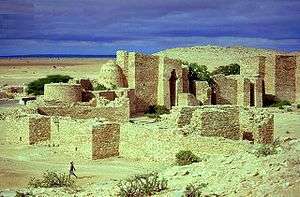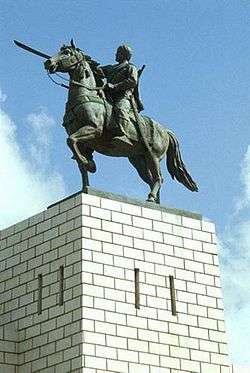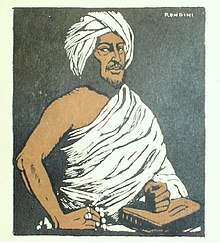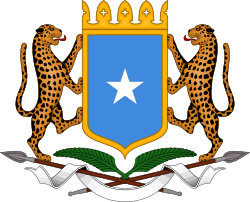Dervish movement (Somali)
| Somali Dervish movement Halgankii Daraawiishta | |
|---|---|
| 1899–1920 | |
| Capital | Taleh |
| Religion | Islam with Sufi-orientation |
| Mullah, Sayid[1] | |
• 1899-1920 | Mohammed Abdullah Hassan |
| History | |
• Established | 1899 |
• Disestablished | 1920 |
The Somali Dervish movement (Somali: Halgankii Daraawiishta) was an armed resistance to the colonial powers – particularly the British – in the Horn of Africa, between 1899 and 1920.[2][3] It was led by the Salihiyya Sufi muslim poet and militant leader Mohammed Abdullah Hassan, also known as Sayyid Mohamed, who aimed for the removal of the colonial state and foreign infidels, the defeat of the Ethiopian forces supporting the colonial powers, and the creation of a Muslim state.[2][3] Hassan established a ruling council called the Khususi consisting of Islamic clan leaders and elders, added an adviser from the Ottoman Empire named Muhammad Ali and thus created a multiclan nationalist liberation movement in what later emerged as Somalia.[3][2][4]
The Dervish movement attracted between 5000 and 6000 youth from different clans over 1899 and 1900, acquired firearms and then attacked the Ethiopian army in the Jigjiga region. The Ethiopian army retreated giving the Dervishes their first success.[5][note 1] The Dervish movement then declared the British colonial administration as their enemy. To end the movement, the British pursued a divide and rule strategy and sought the competing clans as coalition partners against the Dervish movement. The British provided these clans with firearms and supplies, triggering inter-clan warfare. The British also launched punitive attacks between 1900 and 1904 to root out the Dervish army.[2][3] The Dervish movement suffered losses in the field, regrouped into smaller units and resorted to militant guerrilla warfare. Hasan and his loyalist Dervishes moved into the Italian controlled Somaliland in 1905, where Hasan signed the Illig treaty and thereafter strengthened his movement.[2] In 1908, the Dervishes entered the British region again and began inflicting major losses to the colonial powers in the interior regions of the Horn of Africa. The British retreated to the coastal regions, leaving the interior regions to the chaotic clan warfare. The World War I shifted the attention of the colonial forces elsewhere and upon its end, in 1920, the British launched a massive land, air and sea attack on the Taleh forts strongholds of the Dervish movement.[3][5] This decimated the Dervishes, though their leader Mohammed Abdullah Hassan survived the British attack. His death in 1921 due to malaria or influenza ended the Dervish movement.[2][3][7]
The Dervish movement temporarily created a mobile Somali "proto-state" in early 20th-century with fluid boundaries and fluctuating population.[8] It was one of the bloodiest and longest militant movements in sub-Saharan Africa during the colonial era, one that overlapped with the World War I. The battles between various sides – particularly those between the Dervish and the British and between the clans – over two decades killed nearly a third of northern Somalia's population and ravished the local economy.[7][9][10] Scholars variously interpret the emergence and demise of the militant Dervish movement in Somalia. Some consider the "Sufi Islamic" ideology as the driver, others consider economic crisis to the nomadic lifestyle triggered by the occupation and "colonial predation" ideology as the trigger for the Dervish movement, while post-modernists state that both religion and nationalism created the Dervish movement.[3]
Origins
Part of a series on the |
|---|
| History of Somalia |
|
|
|
|
|
|
|
|
According to Abdullah A. Mohamoud, the traditional society of Somalia followed a decentralized structure and a nomadic lifestyle dependent on livestock and pastureland. It was also predominantly Muslim.[2][3] As the European colonial powers expanded their reach in the Horn of Africa, they in cooperation with the Ethiopian army and emperor Menelik, partitioned Somalia and created a centralized form of government. This upset the Somali traditional lifestock and pastureland-based livelihood. The colonial powers were also Christians, states Mohamoud, which created additional suspicions amongst the religious elite of the Somalis.[3] The Ethiopian troops were already a bane for the Somalis as they were the traditional raiders and plunderers of their grazing herds. The arrival of the colonial powers and the consequent partitioning of the land affected the Somalis where Sufi poets such as Faarax Nuur wrote about the traumatic circumstances inflicted on the Somalis by the British, Ethiopians and the Italians.[11] The Dervish movement originated in these circumstances, as a resistance against the colonial designs.[3]
The Dervish movement was led by a Sufi poet and religious nationalist leader named Mohammed Abdullah Hassan, also known as Sayid Maxamad Cabdulle Xasan.[2] According to Said M. Mohamed, he was born in Sacmadeeqo sometime between 1856 and 1864 to a father who was a religious teacher.[2] He studied in Somali Islamic seminaries and later went on Hajj to Mecca where he met Shaykh Muhammad Salah of the Salihiya Islamic Tariqah, which states The Encyclopedia Britannica was a "militant, reformist, and puritanical Sufi order".[12][2] The preachings of Salah to Hasan had roots in Saudi Wahhabism, and it considered it a religious duty "to wage a holy war (jihad) against all other forms of Islam, the Western and Christian presence in the Muslim world, and a religious revival", state Richard Shultz and Andrea Dew.[7] When Hasan returned to the Horn of Africa, the Somali tradition states that he saw Somali children being converted to Christianity by missionaries in the British colony. Hasan began preaching against this religious conversion and the British colonization. He was opposed by the British powers who called him the 'mad mullah', and his Sufi teachings were also opposed by the rival Qadiriya Tariqah – another traditional Sufi group of the region, states Said M. Mohamed.[2][13] Another version of the early events link the illegal sale of a gun to Hasan by a corrupt Somali officer in 1899, who reported his gun as stolen rather than purchased by Hasan.[14] The British demanded the gun's return, while Hasan replied that the British should leave the country, a sentiment he had previously claimed in 1897 when he declared himself "the leader of a sovereign nation".[14] Hasan expanded his arguments against the colonial rule by preaching, the "British infidels have destroyed our [Islamic] religion and made our children their children", states Raphael Njoku.[14]
Hasan left the urban settlement and moved to preach in the countryside. His influence spread in the rural parts and many elders, as well as youth, became his followers. Hasan converted the influenced youth from different clans into a Muslim brotherhood,[12] rallying to protect Islam from the forces of colonialism.[15] These formed the Hasan's armed resistance group to confront the colonial powers, and came to be known as Dervishes or Daraawiish, states Said M. Mohamed.[2]
State

The Dervish movement temporarily created a Somali "proto-state", according to Markus Hoehne.[8] It was a mobile state with fluid boundaries and fluctuating population given the guerilla style militant approach of Dervishes and their practice of retreating to sparsely inhabited hinterland whenever the colonial forces with superior firearms overwhelmed them. At the head of this state was the Sufi leader Hasan with the power of final decision. Hasan surrounded himself with a group of commanders for the militant operations supported by the khusuusi or the Dervish council. Islamic judges settled disputes and enforced the Islamic law in this Dervish state. According to Robert Hess, two of Hasan's chief advisors were Sultan Nur – previously Habr Yunis chief, and Haji Sudi Shabeel also known as Ahmad Warsama from Adan Madoba Habr Toljaala who was fluent in English.[16][17] The regions controlled by the Sufi leader, states Hoehne, mostly belonged to the Dhulbahante and Ogadeen clans, but also a few others such as the Isaaq clans.[8] The fluctuating population of the Dervish often mainly consisted of "the close patrilineal relatives and wives of the followers of Sayyid Mohammed Abdullah Hasan", states Hoehne.[8] Between 1900 and 1913, they operated from temporary local centers such as Aynabo and Illig in northern Somalia, or Beledweyne in central Somalia.[8]
The Dervishes wore white turban and its army utilized horses for movement. They assassinated opposing clan leaders.[8] Dervish soldiers used the dhaanto and geeraar traditional dance-song to raise their esprit de corps and sometimes sang it on horseback.[18] Hasan commanded the Dervish movement soldiers in a martial manner, ensuring that they were religiously committed, powered up for warfare and men of character sworn with an oath of allegiance.[7] To ensure unity among his troops, instead of letting them identify themselves by their different tribes, he made them identify themselves uniformly as Dervish.[19] The movement obtained firearms from Sultan Boqor Osman Mahmud of Majerteen Sultanate, as well as the Ottoman Empire and Sudan.[14] The Dervish fought many battles starting in 1899 against the Ethiopian troops.[7] In 1904, the Dervishes were almost annihilated in Jidbaley. Hasan retreated into the Italian Somaliland and entered into a treaty with them, who accepted the control of Eyl port by the Dervishes. This port served as the Dervish headquarters between 1905 and 1909.[8] During this period, Hasan rebuilt the Dervish movement army, the Dervishes raided and plundered their neighboring clans, and in 1909 assassinated their archrival Sufi leader Uways al-Barawi and burnt his settlement, according to Mohamed Mukhtar.[20]
In 1913, after the British withdrawal to the coast, the Dervishes created a walled town with fourteen fortresses in Taleh by importing masons from Yemen. This served as their headquarters.[21][22] The main fortress, Silsilat, included conical tower granaries that opened only at the top, wells with sulfurous water, cattle watering stations, a guard tower, walled garden, and tombs. It became the residence of Mohammed Abdullah Hassan, his wives and family.[21] The Taleh tower is believed to have had the quarters of a Turk and a German. The Taleh structures also included the Hed Kaldig (literally, "place of blood"), where those whom Hasan disliked were executed with or without torture and their bodies left to the hyenas.[21] According to Muktar, Hasan's execution orders also targeted dozens of his former friends and allies.[20] The town of Taleh was mostly destroyed after a British aerial bombardment in early February 1920, though Hasan had already left his compound by then.[21][23]
The regular army (Maara-weyn) of the Dervish state was organised into seven regiments: Shiikh-yaale, Gola-weyne, Taar-gooye, Indha-badan, Miinanle, Dharbash and Rag-xun. Each regiment had its commander (muqaddim), and varied in size from between 1,000 and 4,000 men. A large para-military force was also drawn from the nomad population. The cavalry, for its part, numbered between 5,000 and 10,000 mounted horsemen, and the standing army was supplied with modern weapons such as rifles and maxim guns.
The Dervish brought important Somali hinterland trade routes under their hegemony, which they exploited by redirecting the wealthy livestock trade to port cities such as Las Khorey, Eyl, and Ilig. Important imports included firearms, horses and building material for the construction of several dozen fortresses in the Horn of Africa. The Dervish state aimed to remove the colonial powers and restore the "Islamic system of government with Islamic education as its foundation", according to Mohamed-Rahis Hasan and Salada Robleh.[24]
Wars against the British Empire and Ethiopia
In August 1898, the Dervish army occupied Burao, an important centre of British Somaliland, giving Muhammad Abdullah Hassan control over the city's watering places. Hassan also succeeded in making peace between the local clans and initiated a large assembly, where the population was urged to join the war against the British.
In 1900, an Ethiopian expedition which had been sent to arrest or kill Hassan looted a large number of camels. Hassan in return attacked the Ethiopian garrison at Jijiga on 4 March of that year and successfully recovered all the looted animals. He gained great prestige in recovering the looted stock from the Ethiopians and he used it along with his charisma and powers of oratory to improve his undisputed authority on the Ogaden. To harness Ogaden enthusiasm into final commitment, Hassan married the daughter of a prominent leader and in return gave his own sister, Toohyar Sheikh Adbile, to Abdi Mohammed Waale, a notable elder.
Towards the end of 1900, the Ethiopian Emperor Menelik II proposed a joint action with the British against the Dervish. Accordingly, British Lt. Col. E.J. Swayne assembled a force of 1,500 Somali soldiers led by 21 European officers and started from Burco on 22 May 1901, while an Ethiopian army of 15,000 soldiers started from Harar to join the British forces intent on crushing the 20,000 Dervish fighters (of whom 40 percent were cavalry).
In the 1920 campaign by the British, 12 aircraft were used to support the local British forces. Within a month, the British had occupied the capital of the Dervish State and Hassan had retreated to the west.
Modern legacy

The Dervish legacy in Somalia has been influential. It was the "most important revivalist Islamic movements" in Somalia, state Hasan and Robleh.[25] The movement and particularly its leader has been controversial in Somalia. Some cherish it as the founder of modern Somali nationalism, while some others view it as an ambitious Muslim brotherhood militancy that destroyed Somalis opportunity towards modernization and progress in favor of a puritanical Islamic state embedded with Islamic education – ideas enshrined in the contemporary constitution of Somalia.[25] Yet others such as Aidid consider the Dervish legacy was one of cruelty and violence against those Somalis who disagreed with or refused to submit to Hasan. These Somalis were "declared Kufr" and Dervish soldiers were ordered by Hasan to "kill them, their children and women and snatch all their property", according to Shultz and Dew.[7][26] Another legacy that came out of the prolonged struggle and savage violence between the colonial powers and the Dervish movement, states Mohamoud, has been the arming of the Somali clans followed by decades of destructive clan-driven militarism, violent turmoil, and high human costs well after the demise of the Dervish movement.[3][27]
Hasan and his Dervish movement have inspired a nationalistic following in contemporary Somalia.[28][29] The military government of Somalia led by Mohamed Siad Barre, for example, erected statues visible between Makka Al Mukarama and Shabelle Roads in the heart of Mogadishu. These were for three major Somali History icons: Mohammed Abdullah Hassan of the Dervish movement, Stone Thrower and Hawo Tako. The castles and fortresses built by the Dervishes were included in a list of Somalia's national treasures. The Dervish period spawned many war poets and peace poets involved in a struggle known as the Literary war which had a profound effect on Somali poetry and Literature, with Mohammed Abdullah Hassan featuring as the most prominent poet of that Age.[30] Many of these poems continue to be taught in Somali schools and have been recited by several Presidents of Somalia in speeches as well as in poetry competitions. In Somali Studies, the Dervish period is an important chapter in Somalia's history and its brief period of European hegemony, the latter of which inspired the resistance movement. Due to their goal of creating a unified Somali State or Greater Somalia transcending regional and clan divisions, many scholars regard the Dervishes as the ideological architects of Somalia[31] and Muhammad Abdullah Hassan himself as the "Father of the Nation".[32]
In popular culture
- The documentary film The Parching Winds of Somalia includes a section on the Dervish struggle and its leader, Mohammed Abdullah Hassan.
- The historic romance novel Ignorance is the Enemy of Love by Farah Mohamed Jama Awl has a Dervish protagonist called Calimaax, who is part of an ill-fated love story and fights against the British, Italians and Ethiopians in the Horn of Africa.
- A 1983, film entitled A Somali Dervish was directed by Abdulkadir Ahmed Said.
- In the Law & Order: Criminal Intent episode Loyalty, references are made to the Dervishes and their leader. The episode also features a character purported to have been descended from Muhammad Abdullah Hassan.
- In 1985, a 4-hour-40-minute Indian-produced epic film by filmmaker Salah Ahmed entitled the Somalia Dervishes went into production. With a budget of $1.8 million, it included an actual descendant of Hassan as its star, and featured hundreds of actors and extras.[33]
- In the popular comic book series Corto Maltese, the protagonist travels to the Horn of Africa during the Dervishes' battle against the British, and witnesses the former power storm a British fort. During these travels, he develops a long-term friendship with a Dervish warrior named Cush, who subsequently features in several other of Corto's adventures around the world.
See also
Notes
References
- ↑ ʻAbdi ʻAbdulqadir Sheik-ʻAbdi (1993). Divine madness: Moḥammed ʻAbdulle Ḥassan (1856-1920). Zed Books. p. 67. Retrieved 19 June 2017.
- 1 2 3 4 5 6 7 8 9 10 11 12 Emmanuel Kwaku Akyeampong; Mr. Steven J. Niven (2012). Dictionary of African Biography. Oxford University Press. pp. 35–37. ISBN 978-0-19-538207-5.
- 1 2 3 4 5 6 7 8 9 10 11 Abdullah A. Mohamoud (2006). State Collapse and Post-conflict Development in Africa: The Case of Somalia (1960-2001). Purdue University Press. pp. 60–61, 70–72 with footnotes. ISBN 978-1-55753-413-2.
- ↑ Mukhtar, Mohamed (2003). Historical Dictionary of Somalia. p. 27.
- 1 2 Abdi Ismail Samatar (1989). The State and Rural Transformation in Northern Somalia, 1884-1986. Univ of Wisconsin Press. pp. 38–39. ISBN 978-0-299-11994-2.
- ↑ Abdullah A. Mohamoud (2006). State Collapse and Post-conflict Development in Africa: The Case of Somalia (1960-2001). Purdue University Press. p. 71 with footnote 81. ISBN 978-1-55753-413-2.
- 1 2 3 4 5 6 Richard H. Shultz; Andrea J. Dew (2009). Insurgents, Terrorists, and Militias: The Warriors of Contemporary Combat. Columbia University Press. pp. 67–68. ISBN 978-0-231-12983-1.
- 1 2 3 4 5 6 7 Markus V. Hoehne (2016). John M Mackenzie, ed. The Encyclopedia of Empire. John Wiley & Sons. doi:10.1002/9781118455074.wbeoe069. ISBN 978-11184-406-43.
- ↑ Michel Ben Arrous; Lazare Ki-Zerbo (2009). African Studies in Geography from Below. African Books. p. 166. ISBN 978-2-86978-231-0.
- ↑ Robert L. Hess (1964). "The 'Mad Mullah' and Northern Somalia". The Journal of African History. Cambridge University Press. 5 (3): 415–433. JSTOR 179976.
- ↑ Abdullah A. Mohamoud (2006). State Collapse and Post-conflict Development in Africa: The Case of Somalia (1960-2001). Purdue University Press. pp. 70 with footnote 79. ISBN 978-1-55753-413-2.
- 1 2 Sayyid Maxamed Cabdulle Xasan, Encyclopedia Britannica
- ↑ David Motadel (2014). Islam and the European Empires. Oxford University Press. pp. 17–18 with footnotes 49–50, 165–166. ISBN 978-0-19-966831-1.
- 1 2 3 4 Raphael Chijioke Njoku (2013). The History of Somalia. ABC-CLIO. pp. 75–76. ISBN 978-0-313-37857-7.
- ↑ Benjamin Hopkins (2014). David Motadel, ed. Islam and the European Empires. Oxford University Press. pp. 150–151. ISBN 978-0-19-966831-1. , Quote: "Men of religious learning and authority were well-positioned in these societies [Somaliland, Sudan, Northwest Frontier of British India] to straddle the disparate and often conflicting interests of local peoples. The protection of Islam became their rallying cry, providing a coherent narrative of and justification for resistance against the forces of colonialism, as well as a unifying force which superseded particularist tribal identities."
- ↑ Robert L. Hess (1968). Norman Robert Bennett, ed. Leadership in Eastern Africa: Six Political Biographies. Boston University Press. p. 103.
- ↑ R. W. Beachey (1990). The warrior mullah: the Horn aflame, 1892-1920. Bellew. pp. 37–44. ISBN 978-0-947792-43-5.
- ↑ Johnson, John William (1996). Heelloy: Modern Poetry and Songs of the Somali. Indiana University Press. p. 31. ISBN 1874209812.
- ↑ Saadia Touval (1963). Somali nationalism: international politics and the drive for unity in the Horn of Africa. Harvard University Press. pp. 57–59.
- 1 2 Mohamed Haji Mukhtar (2003). Historical Dictionary of Somalia. Scarecrow Press. pp. 196–197. ISBN 978-0-8108-6604-1.
- 1 2 3 4 W. A. MacFadyen (1931), Taleh, The Geographical Journal, Vol. 78, No. 2, pp. 125–128
- ↑ Robert L. Hess (1968). Norman Robert Bennett, ed. Leadership in Eastern Africa: Six Political Biographies. Boston University Press. pp. 90–97.
- ↑ Michael Napier (2018). The Royal Air Force: A Centenary of Operations. Bloomsbury Publishing. pp. 33–34. ISBN 978-1-4728-2539-1.
- ↑ Hasan, Mohamed-Rashid S., and Salada M. Robleh (2004), "Islamic revival and education in Somalia", Educational Strategies Among Muslims in the Context of Globalization: Some National Case Studies, Volume 3, BRILL Academic, page 147
- 1 2 Hasan, Mohamed-Rashid S., and Salada M. Robleh (2004), "Islamic revival and education in Somalia", Educational Strategies Among Muslims in the Context of Globalization: Some National Case Studies, Volume 3, BRILL Academic, pages 143, 146-148, 150-152
- ↑ Kimberly A. Huisman (2011). Kimberly A. Huisman, Mazie Hough; et al., eds. Somalis in Maine: Crossing Cultural Currents. North Atlantic Books. pp. 12–13. ISBN 978-1-55643-926-1.
- ↑ Rebecca Richards (2016). Understanding Statebuilding: Traditional Governance and the Modern State in Somaliland. Routledge. pp. 76–77. ISBN 978-1-317-00466-0.
- ↑ Lotje de Vries; Pierre Englebert; Mareike Schomerus (2018). Secessionism in African Politics: Aspiration, Grievance, Performance, Disenchantment. Springer International. pp. 96–97. ISBN 978-3-319-90206-7.
- ↑ Said S. Samatar (1982). Oral Poetry and Somali Nationalism: The Case of Sayid Mahammad 'Abdille Hasan. Cambridge University Press. pp. 20–24, 72–73. ISBN 978-0-521-23833-5.
- ↑ SOMALIA: A Nation's Literary Death Tops Its Political Demise by Said S Samatar
- ↑ Pg 393 – Literatures in African Languages: Theoretical Issues and Sample Surveys By B. W. Andrzejewski, S. Pilaszewicz, W. Tyloch
- ↑ Pg 187 – The Soviet Union in the Horn of Africa: the diplomacy of intervention and Disengagement By Robert G. Patman
- ↑ Exploits of Somalia's national hero becomes basis for movie – Kentucky New Era



